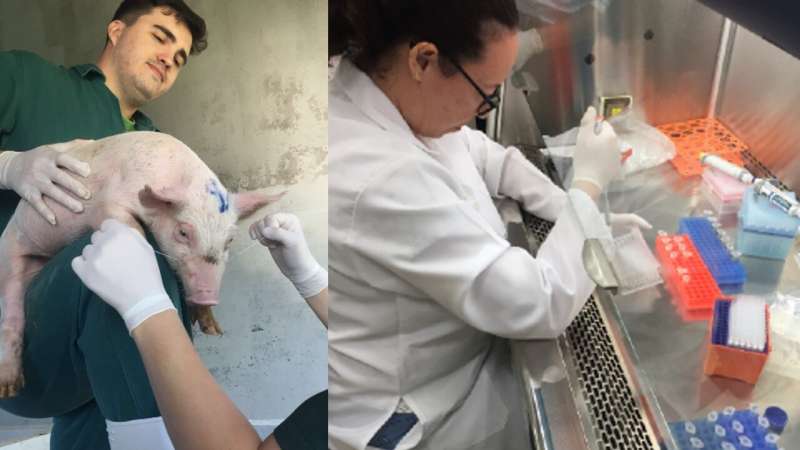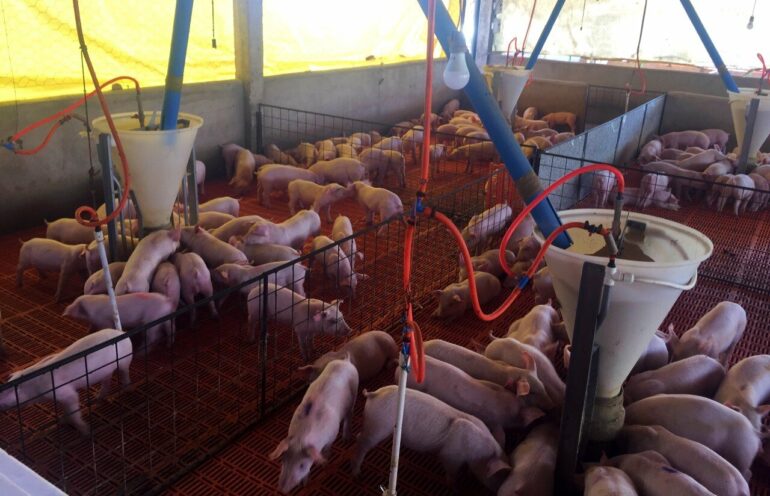Bacteria of the phyla Firmicutes and Proteobacteria, including those of the genus Streptococcus, are the most common microorganisms found in the saliva of swine, which contains a different microbiota from swine feces and the environment in which the animals live.
These were among the findings of a study by researchers at the University of São Paulo (USP) in Brazil and Pennsylvania State University in the United States. According to the researchers, this was the first study ever to characterize the microbial composition of the oral fluid, feces and environment of nursery piglets on commercial farms in Brazil.
An article on the study is published in Scientific Reports. The findings will contribute to the identification of markers of gastrointestinal health in these animals, which produce almost 5 million metric tons of meat per year in Brazil.
The oral cavity is the gateway into the organism for many bacteria that affect the health of most animals, but it can also provide a solution to the problem. In humans, for example, the local microbiota (all microorganisms present in the environment and living in a symbiotic relationship with the host) is known to afford protection against external microorganisms.
The scientific literature contains few studies of the bacterial composition of the oral cavity in pigs, especially the oral fluid, a mixture of saliva and mucosal transudate (fluid derived from the passive transport of serum components through the oral mucosa into the mouth). This was the focus of the study in question.
The authors analyzed oral fluid from 50 weaned piglets living on five large and small commercial farms in São Paulo state. The choice of animals in this age group was not random. Weaning is a very stressful period for piglets because of separation from the sow and the change to a solid diet, which in turn changes the microbiota and can see the emergence of several diseases.
Bacterial compositions of oral, fecal and pen floor samples were determined by 16S rRNA gene sequencing and analyzed using R Studio statistical software. The results showed that most oral fluid bacterial belonged to the phyla Firmicutes (80.4%) and Proteobacteria (7.7%). Streptococcus (Pasteurellaceae) and Veillonella were especially abundant in oral fluid compared to fecal samples, in which Streptococcus was a core genus strongly correlated with other taxa, although there was high variability across the farms.
Fecal and environmental (pen floor) samples were also analyzed to determine microbiota composition. “This was an important stage because the environment in which pigs are raised is the main source of their oral cavity bacteria, and any differences in the bacteria entering and leaving the organism show up in the feces,” said Vera Letticie de Azevedo Ruiz, last author of the article and a professor of veterinary medicine at the University of São Paulo’s School of Animal Science and Food Engineering (FZEA-USP).

Samples of oral cavity fluid were collected and sequenced to determine the composition of their microbiota . © Vinicius Buiatte/The Pennsylvania State University
The most abundant phyla in these samples were Firmicutes, Proteobacteria and Bacteroidota, and the most common genus was Prevotella_9. In contrast with oral fluid, their composition was similar regardless of farm size and cleaning procedures.
“Moreover, alpha diversity [the number of species in individual samples] varied significantly across sample types. It was lower in oral fluid samples than in fecal and pen floor samples,” said Vinicius Buiatte, first author of the study and a researcher in the Department of Animal Science at Penn State.
“In the case of beta diversity [variability of species composition and richness across samples], the communities in fecal samples were closer to those in environmental samples and more distant from those in oral samples.”
Benefits to health and production
According to the researchers, a deeper grasp of oral fluid microbiota serves as a basis for research into microbiomes and for improving swine health and production.
“If you know which microorganisms are most common in a location, you can investigate markers of oral health, for example, or bacteria linked to diseases such as infections of the gastrointestinal and respiratory tracts, and even central nervous system disorders,” Buaitte said.
The results of the study can also create opportunities for the development of solutions to improve swine health and pork production. “This is the case, for example, with prebiotics that facilitate the multiplication and installation of beneficial bacteria,” he said.
Next steps for the researchers include investigating changes in gut microbiome, since oral cavity bacteria were found to differ from fecal bacteria. This involves the analysis, now under way, of five distinct gut segments in 40 piglets.
More information:
Vinicius Buiatte et al, A comparative study of the bacterial diversity and composition of nursery piglets’ oral fluid, feces, and housing environment, Scientific Reports (2024). DOI: 10.1038/s41598-024-54269-5
Citation:
Researchers conduct first-ever study to characterize microbiota in saliva of weaned piglets (2024, May 15)



